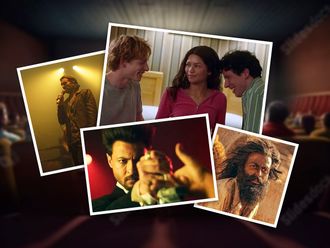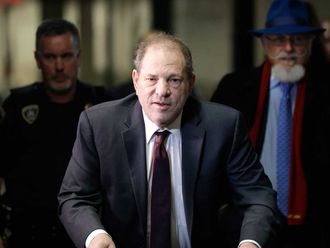_resources1_16a0854a2f1_medium.jpg)
You can’t confuse Willem Dafoe with another actor. That red hair, those fierce eyes, the gaunt cheekbones that make him look hungry for the next intense role — whether it’s as Jesus, the Green Goblin or a motel manager in The Florida Project, the part that just scored him his third Oscar nomination. Even in a fine art museum, his face is still unique.
“I think maybe there’s some figures in a Bruegel painting or something that I thought, ‘Oh, that’s an ancestor of mine’,” Dafoe says. But in his new biopic, At Eternity’s Gate — the film that might get him his fourth Oscar nomination — artist-turned-director Julian Schnabel sticks a paintbrush in Dafoe’s hand and plasters a bandage over his ear and, suddenly, he’s the spitting image of Vincent Van Gogh.
“It never really occurred to me,” says Dafoe of the resemblance. Yet the connection is more than skin-deep. Van Gogh and Dafoe share a restless creativity. Van Gogh moved constantly, searching for inspiration in 20 cities before dying aged 37 of a gunshot wound in Auvers-sur-Oise. “I’d like to find a new light,” he insists in the film. And Dafoe refuses to sit still. “Flexibility is important for an actor,” he says. “Otherwise corruption sets in. You get stuck in certain patterns, and a certain kind of performing language that keeps you from a kind of sense of discovery or danger or mystery.”
He has four films hitting US cinemas this month, and three more already in post-production for next year. “I’ve been apart from the world, working away on these little interior worlds,” says Dafoe. “Basically, I’m like a cloistered nun.”
_resources1_16a0854a2fa_original-ratio.jpg)
Still, the director of Basquiat and The Diving Bell and the Butterfly wasn’t going to shellac Van Gogh in some staid biography of suffering for one’s art. At Eternity’s Gate’s Van Gogh is wily and unpredictable, as is the camerawork bringing him to life. Schnabel shoves the audience inside the painter’s point of view, tramping across fields, staring down at his shoes, squinting at trees and faces so garish and distorted that his attempts to capture them in oils make sense. Schnabel shoots Dafoe from manic angles, somersaulting around him until the audience isn’t sure if the artist has both feet planted in sanity.
Van Gogh isn’t sure, either. When interrogated by a local priest, played by Mads Mikkelsen, who wants to know why he gave his severed ear to a sex worker, Van Gogh has a calm defence: it was meant for Paul Gauguin, played by Oscar Isaac. But when the priest questions his art — “God gave you a gift so you could paint this?” he sneers — a wounded Van Gogh counters: “Why would God give me a gift to paint ugly and disturbing things?”
“He felt like he was painting in a new way,” says Dafoe. In Van Gogh’s letters, which Schnabel used as the film’s foundation, the one thing he trusts is his own talent. “One of the things that changed for me in making this movie was the joyous part of him that we don’t see. He’s usually depicted as the poster boy for the tortured artists, but I would definitely say he’s a hopeful character,” says Dafoe. “History lies!” he laughs.
Dafoe has never hero-worshipped artistic suffering. “I’m not one of those guys that had a picture of Marlon Brando on his wall when I was a kid,” he says. That would have been particularly weird in Appleton, Wisconsin, where Dafoe grew up. His father was a doctor. His mother, a nurse, and most of his seven siblings followed suit.
“I was just a dopey kid that loved being in plays,” says Dafoe, “but I thought that was something that would pass, and one day I’d grow up and become an adult. It’s only after you’ve been working for a while that you say, ‘Well, I guess I’m an actor.’ It sounds suspicious, it sounds like, what, was I asleep? But somewhere deeply, I always thought I’d do something else.”
Flexibility is important for an actor. Otherwise... you get stuck in certain patterns, and a certain kind of performing language that keeps you from a kind of sense of discovery or danger or mystery.
But the man who would grow up to fake his own castration for Lars von Trier’s Antichrist was always pushing limits. For a class project in his senior year of high school, Dafoe filmed on-camera interviews with a pothead, a nudist and a satanist. “Let’s just say they found some of the shooting a little too transgressive, so they locked me out of the editing room, told me to go home and expelled me from school.” He wound up leaving town altogether, first for a year and a half of drama school at the University of Wisconsin-Milwaukee, and then New York, where he joined the infamous Wooster Group, began dating its superstar director, Elizabeth LeCompte, and collided with the rest of the city’s wildest artists, including a young Julian Schnabel.
“It was a very exciting time, but also it was a time of struggle,” says Dafoe. The company’s groundbreaking adaptations of Chekhov and Shakespeare won major awards while the ticket sales barely covered their costs. “It was difficult to survive.” Dafoe began landing film work — villain roles, mostly — until Oliver Stone and Martin Scorsese saw past his sharp features and gave him more empathic parts in Platoon and The Last Temptation of Christ. From there, Dafoe began to fill his career with whatever he found fascinating, be it erotic thrillers with Madonna and action films against Ice Cube, or Wes Anderson wundercabinets and Marvel flicks. He was one of the first actors to straddle superhero blockbusters and serious indies, and still gets asked about selling out.
“I’m not down with the idea of the poor unknown artist is the true artist,” he sighs. “But I do think that with success comes certain things that can corrupt you. That’s the oldest story in the book and I think you just have to be careful.”
An actor has a harder time assembling a defined body of work than a painter who controls every brush stroke. Onscreen, even an unusual creature such as Dafoe is still seen through his director’s choices. Line up his films in a gallery and it would be hard to spot the creative through-line except for the intensity of his performances. “Look, it’s always on your mind: ‘Jack of all trades, master of none’,” he says. “To some people, I’m Willem Dafoe of Spider-Man movies. For other people, I’m Willem Dafoe of Lars von Trier. Those two worlds don’t always intersect in people’s minds.
“Actors are famously inarticulate about what we do because it’s mysterious work. Any time you really try to describe it, buzzers and lights go off in my head because of the lie-lie-lie-[expletive]-[expletive]-[expletive],” says Dafoe.
Kind of like that scene in At Eternity’s Gate when Van Gogh tries to explain his method of painting trees to a group of kids who pelt him with rocks. At least Dafoe has been rewarded with fantastic feedback while alive. “I think you do need encouragement,” he says. “There are people that it wears down.” But he has been acting for longer than Van Gogh was alive — and still approaches each new film with the openness of a blank canvas.
“I like working from a place of zero and going towards something. Some people really respond to the idea of nailing it or executing it to perfection. I like perfection, I appreciate that. But I’m much better trying to find something than I am knowing something and executing and explaining it,” says Dafoe. “I think it’s the difference between a craftsman and an artist. I aspire to be an artist.”












